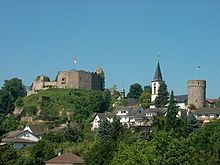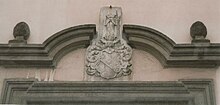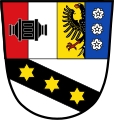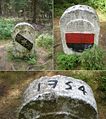Lindenfels (noble family)
The von Lindenfels family is an old German noble family from the Franconian and Upper Palatinate region.
The name Lindenfels

The barons of Lindenfels, who are based in Franconia and the Upper Palatinate, come from Lindenfels Castle in the Odenwald in the Hessian district of Bergstrasse , which was founded by Lorsch monastery bailiff Count Berthold the Younger von Hohenberg in the early 12th century to protect the nearby Lorsch monastery . Count "Bertolf von Lindenfels" was the first to be mentioned in a document in 1088. The family thus belongs to the ancient nobility. As a father of a family of related to that Count Berthold the Younger applies Billung of Lindenfels , who in 1151 as one of the four noble free founder of the monastery Bronnbach appeared in Wertheim. There are other seats called Lindenfels.
history
The 1531-born Philipp von Lindenfels, son of Stephen II. Lindenfels, Obervogt the Counts of Zollern in Hechingen and Vogt in Rottenburg , probably came the mediation of Count Jos Niklas II. Of Zollern as caregivers of counts of Wolfenstein Castle Obersulzbürg at Neumarkt in the Upper Palatinate. His wife Anna, née Countess von Zollern, died there in 1565 and was buried in the church in Pyrbaum . Eventually he was electoral Palatinate judge of the secularized monastery Speinshart , where in 1598 his second wife Maria, née. Late von Zwiefalten, died. He himself died on May 27, 1600 and was buried by her side in the monastery church in Speinshart. Since no children had resulted from his two marriages, Philipp appointed his nephew Hans Kaspar II von Lindenfels as heir and bequeathed his brother Hans Walter the elder and his brother Hans Georg's daughters, Walburga and Marie, with legacies. After the death of his father Hans Kaspar I, an attorney at the Imperial Court of Justice in Speyer , Hans Kaspar II moved in 1573 with his mother to live with his uncle in the Upper Palatinate. At the opening of Philip's will on August 1, 1600, he was designated as the deputy monastery judge in Speinshart. In 1609 he married Martha Cordula von Künsberg , a daughter of Ludwig Christoph von Künsberg zu Weidenberg . He lived in Nairitz Castle, inherited from his uncle . There he died on January 2, 1634. On his epitaph in Thumsenreuth Castle it says:
“Anno Domini 1634, January 2nd, is blessedly different in God, the noble born and strict Mr. Hans Kaspar von Lindenfels uff Nairitz, the name of the other, his age 71 years [and] several months, which is the last of this ancient Gender and tribe, also already over 50 years old, before he married to the presumably noble born, many virtuous young woman Mariam Cordulam von Künsberg from the house of Weidenberg, her age at 18 years, with whom he had 5 sons and 3 daughters ... "
Nairitz
Nairitz , the Upper Palatinate family estate of the von Lindenfels family, was a fiefdom of the Landgraves von Leuchtenberg . In 1584/85 Philipp von Lindenfels acquired it from the widow Katharina von Künsberg . After the death of Hans Kaspar II, Nairitz first fell to his eldest son Jobst Bernhard I, who in 1640 acquired the two manors in Windischenlaibach near Speichersdorf from Georg Sigmund Hundt auf Thumsenreuth and his brothers .

Ten years later, Jobst Bernhard I von Lindenfels increased his property by buying the neighboring Upper Palatinate country estate of Guttenthau from Heinrich Senfft von Pilsach . In 1643 Jobst Bernhard I married his mother's niece, Ursula Amalia von Künsberg . In 1659 his wife's brother, Johann Ludwig von Künsberg, died without a male heir and Jobst Bernhard intended to acquire the Lower Castle in Weidenberg . Margrave Georg Albrecht zu Brandenburg, who did not agree, prevented the purchase, whereupon Jobst Bernhard I withdrew to his estates in Windischenlaibach and Guttenthau. As early as 1658, Jobst Bernhard I, together with his brothers Wolf Ernst auf Weidenberg and Hans Walter auf Nairitz and Höflas, concluded a family contract, the imperial confirmation of which in 1664 also recognized the family's membership of the Franconian Imperial Knighthood. In 1661, Jobst Bernhard I acquired one of the later headquarters of his family, the Thumsenreuth estate , from Ernst Odowalsky von Streitberg . He had already given Nairitz to his brother Hans Walter the Younger around 1650. Nairitz remained in the possession of his descendants until 1743; On July 29th of this year, Ludwig Christoph Adam, the Nairitz line of the Lindenfels family, died.
Thumsenreuth
Thumsenreuth came in 1661 from the property of Ernst Odowalsky von Streitberg to Jobst Bernhard I. von Lindenfels. After the acquisition of Thumsenreuth, he had the castle there renovated, which is reminiscent of the Lindenfels / Künsberg marriage coat of arms on the doorway and the year 1662. After Jobst Bernhard I's death in 1679, his older son Hans Achatz received the Thumsenreuth estate. He sold Guttenthau to Hans Christoph Erdmann von Sparneck . With the eight children he fathered with his wife Eva Maria von Trautenberg , he became the progenitor of the Thumsenreuth line of the family, which is still flourishing today. Thumsenreuth Castle is still inhabited by the barons of Lindenfels. Trautenberg Castle and Castle have also been owned by the family since 1890.
Windischenlaibach fell to Jobst Bernhard II von Lindenfels after 1679; he sold this property in 1691 to his brother Hans Achatz zu Thumsenreuth, who two years later sold it to his brother-in-law Christoph Wilhelm Teuffel von Birkensee on Pilgramsreuth.
Erkersreuth

Bernhard I's younger son, Jobst Bernhard II. Von Lindenfels, had been the margravial Brandenburg governor in Wunsiedel from 1685 (see also the list of officials in the six-office region ). After he had acquired the Schönwald manor from Erdmann Friedrich Rab in 1689 , he also bought the neighboring manor of Erkersreuth near Selb, which had fallen back five years earlier due to the extinction of the Lords of Raitenbach, from Margrave Christian Ernst in 1696 . After the death of Jobst Bernhard II in 1704, his property fell to his five sons. Little by little, Johann Christian August von Lindenfels took over his brothers' inheritance shares. In 1748 he built the still existing new castle in Erkersreuth. Since he had no offspring, Johann Christian August sold his Erkersreuther property in 1752 to his nephew Ludwig Martin von Lindenfels zu Bug and Weißdorf . Erkersreuth remained in the possession of his descendants until 1800. Because of his debts, Adam Karl von Lindenfels had to sell it to Minister Theodor von Kretschmann .
Schönwald fell to Leo Bernhard von Lindenfels, who, as his father's successor, held the post of governor in Wunsiedel . In 1711 he sold the Schönwald manor to the Hofer Oberumgeldeinnehmer and margravial councilor Wolf Christoph Schmidt, perhaps in order to be able to build a representative town house in Wunsiedel with the proceeds. The Palais Lindenfels, located diagonally across from the town church in Wunsiedler Maximilianstrasse, is already mentioned among the buildings that burned down there in 1731; in its current neat late baroque form it was created around 1735. Leo Bernhard von Lindenfels worked as governor in Wunsiedel for almost 40 years. He died there on March 3, 1742 and was buried in the town church. The Erkersreuther line went out in 1915 in the male line with Ernst Arno Freiherr von Lindenfels at Reislas Castle .
Willow Hill
The von Lindenfels family and the von Künsberg family on Weidenberg have been married several times. In 1648 Wolf Ernst von Lindenfels, the fourth son of Hans Caspar II, succeeded in acquiring the Upper Castle in Weidenberg from the heirs of Jobst Bernhard von Künsberg. He had the castle, which had been badly dilapidated in the Thirty Years' War, "raised to its seat and A. in 1653 brought to full status". The Lower Palace, in which after the death of Johann Ludwig von Künsberg his brother-in-law, Jobst Bernhard I von Lindenfels had shown interest in buying, was taken over by the sovereign. With his wife Ursula Amalia, b. von Giech zu Buchau, Wolf Ernst fathered a total of 20 children. The Upper Castle in Weidenberg, including the dispute with the margravial administrators of the Lower Castle over jurisdiction, which had been going on since 1661, was bequeathed to his son Carl Urban in 1692, who thus became the progenitor of the family's Weidenberg-Reislaser line, which flourished until 1884. Tired of the constant quarrels, Carl Urban handed the estate over to his son Carl Willibald in 1720. He sold the Upper Palace to Margrave Friedrich zu Brandenburg in 1745 and withdrew to the Reislas manor .
Wolframshof
Carl Christian Ernst von Lindenfels, a brother of Carl Urban, can be found in the Upper Palatinate Landsassenregister since 1728 as the owner of the Wolframshof estate . The former Leuchtenberg fiefdom had previously been owned by the von Lüschwitz family since 1617 . The Wolframshofer line of the family founded by Carl Christian Ernst existed until 1982.
coat of arms
The coat of arms of the von Lindenfels is a sloping bar with three gold stars on a silver (also blue?) Background. The crest shows a man's armored torso without arms, wearing a belt with the three stars and a headgear in gold.
In its coat of arms, the municipality of Speichersdorf commemorates the family who owned the Hofmark and held jurisdiction over the area. Their seat was Guttenthau Castle.
Coat of arms on the family crypt of the Lindenfels-Reislas family in the Bayreuth cemetery
Coat of arms of the municipality of Speichersdorf
Coat of arms of Seybothenreuth
Coat of arms of Erkersreuth (Selb)
Boundary stone from 1754 near Nový Žďár - Neuenbrand (Sudetenland)
literature
- Johann Gottfried Biedermann : Gender register of the Reichs-Frey-immediate knighthood of Francken, praiseworthy locality. Bamberg 1747.
- Ernst Heinrich Kneschke : New general German nobility lexicon . 5th volume, Leipzig 1864.
- Joachim Kröll: History of the market Weidenberg. Weidenberg 1967.
- Rudolf Richter: Local history of the place Erkersreuth. Same 1950.
- Bernhard Hermann Röttger : The art monuments of Upper Franconia, Bd. 1: District of Wunsiedel and urban district of Marktredwitz. Munich 1954.
- Harald Stark : The Notthracht family - looking for traces in Egerland, Bavaria and Swabia . Weißenstadt 2006. ISBN 3-926621-46-X
- Heribert Sturm : Historical Atlas of Bavaria. Part of Altbayern issue 40. Kemnath, Munich 1975.
- Heribert Sturm: Historical Atlas of Bavaria. Part Altbayern issue 47. Neustadt / Waldnaab, Weiden, Munich 1978.
- Richard Winkler: Historical Atlas of Bavaria. Part Franconia, series 1, issue 30: Bayreuth, Munich 1999.
- Hans Wohlrab: Schönwalder Heimatbuch. Schönwald 1968.
Web links
- The one from Lindenfels at notthphia.de in Thumsenreuth
- Albert Elstner: The von Lindenfels in the history of the Künsberg
- Family crypt of those from Lindenfels in the church in Weidenberg
- History of the municipality of Speichersdorf
- ( Page no longer available , search in web archives: The von Lindenfels in Marktredwitz )
Individual evidence
- ↑ landesarchiv-bw.de
- ^ History of Weinheim ( Memento from September 19, 2008 in the Internet Archive )
- ^ History of Meerbachtal ( Memento from April 15, 2008 in the Internet Archive )
- ↑ gutlindenfels.de
- ↑ Picture with the coat of arms of those of Lindenfels











